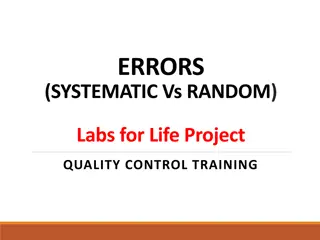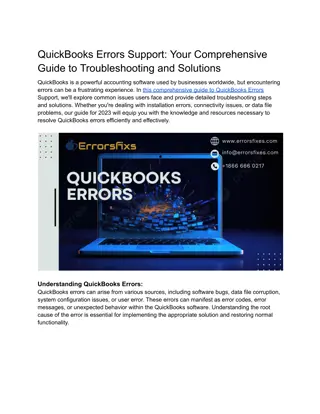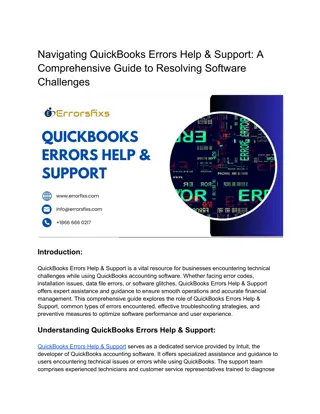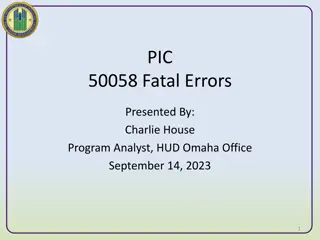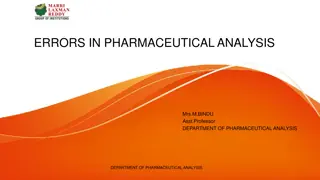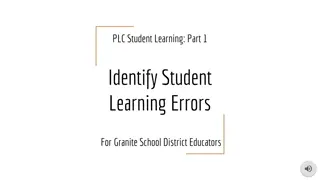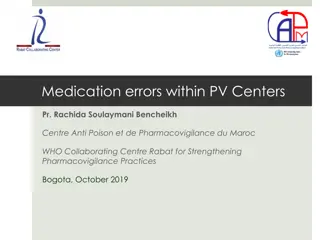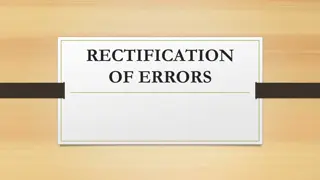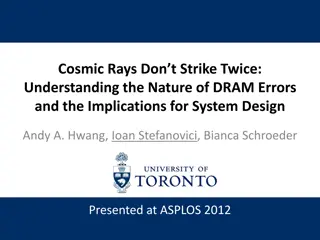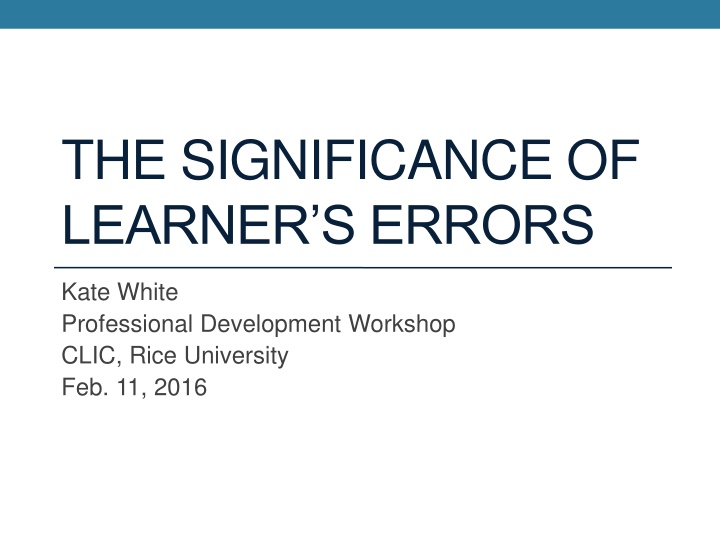
Learner Errors: Importance, History, and Methods
Explore the significance of learner errors in language acquisition, including their historical context and the impact of teaching methods like the audiolingual approach. Understand the evolution of error analysis and its implications for language learning and teaching strategies.
Download Presentation

Please find below an Image/Link to download the presentation.
The content on the website is provided AS IS for your information and personal use only. It may not be sold, licensed, or shared on other websites without obtaining consent from the author. If you encounter any issues during the download, it is possible that the publisher has removed the file from their server.
You are allowed to download the files provided on this website for personal or commercial use, subject to the condition that they are used lawfully. All files are the property of their respective owners.
The content on the website is provided AS IS for your information and personal use only. It may not be sold, licensed, or shared on other websites without obtaining consent from the author.
E N D
Presentation Transcript
THE SIGNIFICANCE OF LEARNER S ERRORS Kate White Professional Development Workshop CLIC, Rice University Feb. 11, 2016
Our Plan 1. Why are errors important? 2. What do we do with errors? 3. Practical applications for teaching and learning
WHY ARE ERRORS IMPORTANT?
What is an error? an unsuccessful bit of language (James, 1998, p. 1)
History of errors Until the 70s, we thought all errors were due to L1 transfer, but analysis showed that the L1 cannot be the source of all errors (Lightbown & Spada, 2013) What caused our reanalysis of errors?
The audiolingual method Dominant L2-teaching method of the 1960s and 1970s Based on behaviorism A psychological theory that all learning, whether verbal or non- verbal, takes place through the establishment of habits. According to this view, when learners imitate and repeat the language they hear in their surrounding environment and are positively reinforced for doing so, habit formation (or learning) occurs. (Lightbown & Spada, 2013, p. 213-14)
The audiolingual method Dominant L2-teaching method of the 1960s and 1970s Based on behaviorism Stimulus-response and habit formation -> learning In this method, students rarely use the language spontaneously. Teachers avoid letting beginning learners speak freely out of concerns that this would allow them to make errors. The errors, it is said, could become habits. (Lightbown & Spada, 2013, p. 155)
The audiolingual method Example 1: (from Lightbown & Spada, 2013, p. 155) (A group of 15-year-old students involved in an exercise based on the simple present of English verbs.) S1: And uh, in the afternoon, uh, I come home and uh, uh, I uh, washing my dog. T: I wash. S1: My dog. T: Every day you wash your dog? S1: No. [ben] S2: Il n a pas de chien! (He doesn t have a dog!) S1: Non, mais on peut le dire! (No, but we can say we do!)
The audiolingual method Example 2: (A group of 12-year-old learners of English as a foreign language.) T: Repeat after me. Is there any butter in the refrigerator? Class: Is there any butter in the refrigerator? T: There s very little, Mom. Class: There s very little, Mom. T: Are there any tomatoes in the refrigerator? Class: Are there any tomatoes in the refrigerator? T: There are very few, Mom. Class: There are very few, Mom.
The audiolingual method What are the problems here? What is the point of pure repetition ?
Corder (1967) Corder saw that teachers were dismissing errors as a matter of no particular importance, as possible annoying, distracting, but inevitable by-products of the process of learning a language about which the teacher should make as little fuss as possible , yet also avoid at all costs (p. 162) Two points of view in the audiolingual method: 1. With a perfect teaching method, errors won t happen 2. Errors will always occur because we re human
Corder (1967), cont. How does Corder define intake? The simple fact of presenting a certain linguistic form to a learner in the classroom does not necessarily qualify it for the status of input, for the reason that input is what goes in not what is available for going in, and we may reasonably suppose that it is the learner who controls this input, or more properly his intake. (p. 165) *The first to suggest this distinction, input vs. intake*
Review of terms Input: the language to which a learner is exposed either orally or visually (Corder, 1967) the language that the learner is exposed to (either written or spoken) in the environment (Lightbown & Spada, 2013, p. 219) Intake: language that is available to and utilized in some way by the learner (Corder, 1967) Language that the learner attends to and comprehends in some way Interlanguage: what if the language produced by second-language learners is systematic? (Tarone, 2014, p. 23) Transitional competence: the learner is using a definite system of language at every point in his development the learner s errors are evidence of this system and are themselves systematic. (Corder, 1967, p. 166)
Discussion Corder (1967) Why were Corder s suggestions and ideas considered groundbreaking at the time? How does a change in focus from instruction to learning affect our understanding of second language acquisition? On page 166, Corder asserts that errors are adventitious artefacts[sic] of linguist performance and do not reflect a defect in our knowledge of our [L1] it would be quite unreasonable to expect the learner of a second language not to exhibit such slips of the tongue (or pen), since he is subject to similar external and internal conditions when performing in his first or second language. Corder then distinguishes between errors of this nature, which he terms mistakes, and errors that reveal [the learner s] underlying knowledge of the language to date , a construct that has later been understood as the learner s interlanguage. In your own teaching experience, have you seen both mistakes and errors? Are they easy to distinguish? 1. 2. 3.
Corder (1967), cont. Error: systematic, related to competence Mistake: non-systematic, related to performance Why are errors significant? (p. 167) 1. Show teachers how far the learner has progressed 2. Provide evidence to researchers about the process of learning the second language 3. Provide opportunities for learner to learn and test hypotheses about language
Are errors always obvious? Lightbown & Spada (2013): learners sometimes avoid using some features of language that they perceive to be difficult for them , leading to the absence of certain errors in their speech (p. 45) Sometimes language acquisition progress is reflected in a decrease in the use of a correct form that was based on rote memorization or chunk learning. New errors may be based on an emerging ability to generalize a particular grammatical form beyond the specific terms with which it was first learned. In this sense, an increase in errors may be an indication of progress (p. 41) What does this mean? Can you think of any examples?
Example I buyed a ticket This learner may actually know more about English than a learner who says I bought a ticket the latter may be a memorized chunk, we can t tell without more information from that learner. The learner who says buyed obviously knows that ed is a marker of the past tense in English and is developing their understanding of when and why to use that rule. (Lightbown & Spada, 2013)
Errors as evidence Progress to a higher level does not always mean fewer errors (Lightbown & Spada, 2013) From Corder (1967, p. 168): Utterance of a correct form cannot be taken as proof that the learner has learned the systems which would generate that form Only the situational context could show whether [a learner s utterance] was an error or not
Error sources L1 interference Gaps in knowledge Overgeneralization of a rule/hypothesis testing Hypercorrection Analogy/false analogy Incompleteness of knowledge Misanalysis What else? Can be more than one at once
Error sources L1 interference Gaps in knowledge Overgeneralization of a rule he, that was a great person Hypercorrection seventeen years old girl Analogy/false analogy childs Incompleteness of knowledge no one knew where was she Misanalysis They are carnivorous plants and its name What else? Can be more than one at once
Error types In: Grammar Pragmatics Acceptability Pronunciation Vocabulary Syntax/word order What else?
Corder (1967), cont. No advances in teaching can be made until we understand what learners bring to the task of acquisition the position taken here is that the learner s possession of his native language is facilitative and that errors are not to be regarded as signs of inhibition, but simply as evidence of his strategies of learning (p. 168) We maybe able to allow the learner s innate strategies to dictate our practice and determine our syllabus; we many learn to adapt ourselves to his needs rather than impose upon him our preconceptions of how he ought to learn, what he ought to learn and when he ought to learn it (p. 169)
1970s Application of new ideas and efforts to refute behaviorism Research on error analysis and input 1972 Selinker introduced the construct of interlanguage Ex. Wagner-Gough & Hatch (1975) authors argued that learners learn syntax from the input and interaction with NSs. At the time, this was a radical way of looking at the role of syntactic learning because the then-current orthodox position, particularly among those involved in classroom teaching, was that conversational interactions were used to practice forms, not learn them (Gass, 1997)
1980s - now Focus on role of formal instruction in L2 development Various methods that focus on establishing form-meaning connections and encouraging intake from input New methods (ex. communicative) that are learner-focused (both linguistically and cognitively) rather than teacher- focused New methods that focus on learning through interaction
Takeaways from Corder (1967) Focus on learners and learning processes Terminology: intake, errors vs. mistakes Errors are important as evidence and occur in context In SLA we ask ourselves, how do learners come to internalize and use the linguistic system of another language? We ask this because Corder asked it first.
WHAT DO WE DO WITH ERRORS?
What do we do with errors? Lightbown (1980): One of the most important accomplishments of SLA is showing that learner language does have structure Selinker (1972): the L2 learner s internal linguistic system is worthy of study in its own right, and it is not a corrupted version of the L2 How do we know that?
Output & Interlanguage Lightbown & Spada (2013): Teachers and learners cannot read learners minds, so they must infer what learners know from what they do. (p. 41) Learners produce sentences that are not exactly like those they have heard. These new sentences appear to be based on internal cognitive processes and prior knowledge that interact with the language they hear around them. The interlanguage is a developing system with rules and patterns it is not simply an imperfect or corrupted version of the target language
Interlanguage: a definition A learner s developing second language knowledge. It may have characteristics of the learner s first language, characteristics of the second language, and some characteristics that seem to be general and tend to occur in all or most interlanguage systems. Interlanguages are systematic, but they are also dynamic. They change as learners receive more input and revise their hypotheses about the second language. (Lightbown & Spada, 2013, p. 220)
Learning process Input > Intake > Interlanguage > Output
Errors & Interlanguage Errors are a natural and valuable part of the language learning process (Lightbown & Spada, 2013, p. 156) Errors reflect the patterns of learners developing interlanguage systems showing gaps in their knowledge, overgeneralization of a second language rule, or an inappropriate transfer of the first language pattern to the second language, among other things (p. 208)
Bardovi-Harlig (2014) In order to illustrate Selinker s claim that interlanguage is a system in its own right, she considers evidence for the state of learners interlanguage in three past studies on tense-aspect morphology, pragmatics, and conventional expressions Important: we must consider what forms are available to the learner in their development of alternatives (p. 137)
Bardovi-Harlig (2014), cont. Two approaches: 1. Study the meanings that a learner associates with one form over time 2. Study the forms that a learner associates with one concept over time The latter is a study of the development of alternatives , which are attached to the learner s pre-existing conceptual knowledge (for the most part) In other words, the development of more than one way to express a concept in the second language
Bardovi-Harlig (2014), cont. Study 1: reverse-order reports When events in a narrative are reported in reverse order Ex. I ate my lunch after my wife came back from her shopping. (B-H, 2014, p. 131) Findings: Learners use reverse-order reports and follow the maxim of overtly signaling non-chronological sequences Tools: morphological contrast (tense/aspect), adverbials, syntactic devices, complementation, relative clauses (p. 132) Examples on pg. 133 Often they use more than one tool
Discussion Bardovi-Harlig (2014) In the section on the study of tense-aspect morphology, Bardovi-Harlig points out that her findings, which indicate that learners recognize the need to mark reverse-order reports, are only obvious because her analysis is not focused on either correct forms or errors (p. 135). Instead, she considers her approach one from the interlanguage perspective, which means that she focuses on how the learners perform the same action (reverse-order reports) as the native speakers, only with the linguistic material at the learners disposal. What could you gain in the classroom by adopting this approach when analyzing your students L2 performance? 1. Ex. 18: After that the policeman caught him In the car, there are many people who did bad things.
Bardovi-Harlig (2014), cont. Study 2: pragmatics Bardovi-Harlig illustrates how, over time, learners develop more alternatives for expressing the same concept, allowing broader pragmatic expression (or more nuanced expression of concepts) In this way, grammatical knowledge and pragmatic ability are linked She calls this a full tool kit (p. 137) Without the full tool kit, learners might not have a choice to make, resulting in pragmatic errors that reveal the state of their interlanguage development Can you think of any examples of students lacking a full tool kit that you have encountered?
Bardovi-Harlig (2014), cont. Study 3: conventional expressions Multi-word routine expressions, often learned as chunks in initial stages Computerized conversation simulations
Example You go to a clothing store and you need to find a new shirt. A salesperson approaches you. You don t want the salesperson s assistance. Salesperson (audio): Can I help you? You say:
Bardovi-Harlig (2014), cont. Study 3: conventional expressions Multi-word routine expressions, often learned as chunks in initial stages Computerized conversation simulations Findings: Learner responses showed that interlanguage grammar was stronger than the influence of input for conventional expressions It is also clear that learners often know what the target expression is, even when the string produced by the interlanguage grammar is distinct from the target structure as evidenced by the use of the correct words in incorrect grammatical form (p. 142)
Discussion 2. In the section on conventional expressions, Bardovi-Harlig considers how learner attempts at conventional expressions are influenced by both input and interlanguage grammar (p. 143). How do learners attempts at these expressions reflect interlanguage grammar? Have you seen examples like the ones she provides (p. 142-143) in your students speech? Learner ranges for conventional expressions: I just look, I just looking, I ll just looking, Just I m looking, I am just looking (p. 142) Ungrammatical: I m sorry for late, I m sorry for I m late, I m sorry about late, I m so sorry about my late, I m so sorry to being so late, I m sorry because I late Grammatical: Sorry for being late, I m sorry to be late, I m sorry to come late, Sorry for coming late (p. 143)
Bardovi-Harlig (2014), cont. So, even for phrases learned as chunks, learners interlanguage grammar can produce variants that reveal the current state of their interlanguage development Learners may exhibit native-like understanding of what they should do in a conversation, but may not have the full tool kit with which to do it Ex. Reverse-order marking Ex. Pragmatics
Discussion: errors Which aspects of learners interlanguage are most likely to affect their ability to use language effectively outside of the classroom? Do you think priorities for classroom interaction and instruction reflect the importance of these different language features? Ex. Word order, grammatical morphemes, vocabulary, phonology, pragmatics Ex. Research on pronunciation has shown that second language speakers ability to make themselves understood depends more on their ability to reproduce the phrasing and stress patterns the melody of the language than on their ability to articulate each individual sound. (Lightbown & Spada, 2013, p. 206)
Discussion: errors Have you ever noticed: In a controlled activity, your students conjugate a verb correctly. Afterwards, in a more open-ended activity (conversation, a game, composition, etc.) they make an error with the conjugation. What does this show you about the state of their interlanguage?
Activity 1: Analyzing learner language See handout. Adapted from Lightbown & Spada (2013)
PRACTICAL APPLICATIONS For teaching and learning
Errors, SLA, and teaching Research in SLA can offer realistic expectations about teaching and learning This, it could be argued, was the overarching goal of switching our focus from the teacher to the learner
Applications: 1. Methods 2. Form-focused instruction 3. Corrective feedback
Methods Get it right from the beginning vs. Get it right in the end Beginning: audiolingual, structure-based End: communicative, interaction-based
Methods, cont. Adult learners may express a preference for structure- based approaches, such as the audiolingual method or grammar translation method. Why? Learners may prefer what they know and have experienced The failure of these methods in the classroom (and in research) led to many looking for something new (ex. the communicative method) Learners in a classroom setting bring individual differences, which is seen as one of the downfalls of the audiolingual method (Lightbown & Spada, 2013)
Methods, cont. Get it right from the beginning vs. Get it right in the end Beginning: audiolingual, structure-based, no errors End: communicative, interaction-based, errors are a natural part of learning a second language Findings from research: Focusing on no errors leads to no communicative competence Ex. Opportunities for freer communication did not cause learners to do less well on measures of linguistic accuracy (Lightbown & Spada, 2013, p. 159) Learners benefit from opportunities for communicative practice when the focus is on understanding and expressing meaning


